Scottish Natural Capital Accounts: 2020
This report gives estimates of the quantity and value of services supplied by Scottish natural capital covering:
Agricultural biomass
Fish capture
Timber
Water abstraction
Minerals
Fossil fuel
Renewable energy
Carbon sequestration
Air pollution removal
Noise mitigation
Urban cooling
Recreation
5. Provisioning services
Provisioning ecosystem services create products that include food, water and materials. These are produced by nature and then consumed by society.
Provisioning services currently included in the Scottish ecosystem accounts are:
- agricultural biomass
- fish capture
- timber
- water abstraction
- minerals
- fossil fuels
- renewable energy
Index of provisioning service physical flow, Scotland, 2004 to 2017
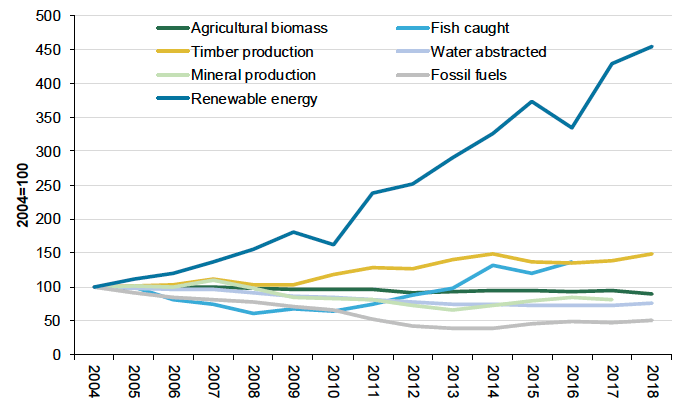
Source: Office for National Statistics, Scottish Government, European Commission: Scientific, Technical and Economic Committee for Fisheries, Forestry Commission and Scottish Water
Historically in Scotland fossil fuels have represented most of the provisioning service valuation but in 2016 this abiotic service represented only 40% of the value. Looking at the other services in 2016, agricultural biomass made up nearly a quarter of the total, followed by fish capture (11%).
Annual value of provisioning services, Scotland, 2016
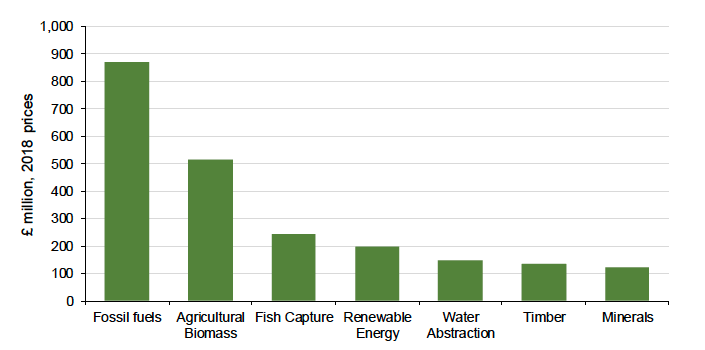
Sources: Office for National Statistics, Scottish Government, European Commission: Scientific, Technical and Economic Committee for Fisheries, Forestry Commission and Scottish Water
Between 2011 and 2016, the total value of provisioning services in Scotland declined by 90%, largely because of a steep decline in the value of fossil fuels.
The UK has also seen a similar decline over the same period again caused by a fall in fossil fuels. Scotland represented 22% of the UK provisioning service value in 2016 from a peak of 81% in 2007.
Aggregate annual value of provisioning services, UK and Scotland, 2004 to 2016
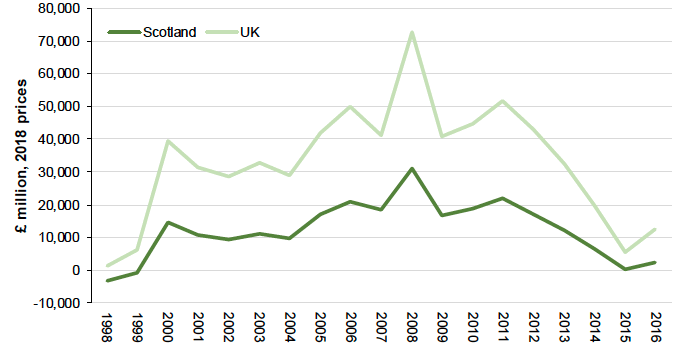
Source: Office for National Statistics and Scottish Government
Notes:
1. Renewable generation excluded prior to 2008 because of lack of data.
2. Fish capture excluded prior to 2015 because of lack of data.
Agricultural biomass
Agricultural biomass is the value of crops, fodder and grazing, which supports agricultural production in Scotland. Farmed animals are not included in these estimates as they are considered produced rather than natural assets. The food eaten by farmed animals, such as grass and feed, is included.
The volume of agricultural biomass in Scotland was 15.59 million tonnes in 2018, a 9.4% decrease since the value of 17.20 million tonnes in 2003. This is the lowest it has been recorded over this 16-year period.
One of the main reasons for this large decline is a fall in livestock (Scottish Agricultural Census 2019), which is shown in grazed biomass production. This used to make up nearly one-third of the agricultural biomass production total but is now responsible for only one-quarter.
Agricultural biomass production, Scotland, 2003 to 2018
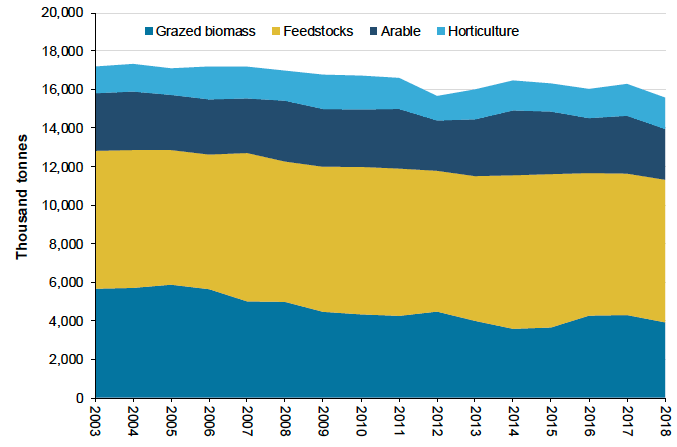
Source: Office for National Statistics and Scottish Government
It is easy to see from Figure 5 that both grazed biomass and feedstocks have continuously contributed the most to agricultural biomass production. Grazed biomass declined by 30.8% between 2003 and 2018, whilst feedstocks increased 3.4% over the same period. In 2018, both feedstocks and grazed biomass made up 72.6% of the overall production for Scotland.
Previous Scottish natural capital accounts have provided resource rent annual valuations using the residual value approach. This is the surplus value to the agricultural industry after all costs have been considered. Estimated at an aggregate scale it may include non-agricultural aspects of farm businesses.
As part of our development, we will look at alternative measures of capturing food production value. We have compared the industry resource rent residual value approach with an aggregated whole farm income and farm rent approach. Whole farm income is the total income from agricultural production (excluding subsidies) net of costs (excluding taxes). This is like the residual value approach but calculated at a farm output level. Farm rent is an imputed estimate of total rental costs for agricultural land. For further details on these approaches please see the methodology section.
Agricultural biomass annual value methods comparison, Scotland, 1998 to 2017
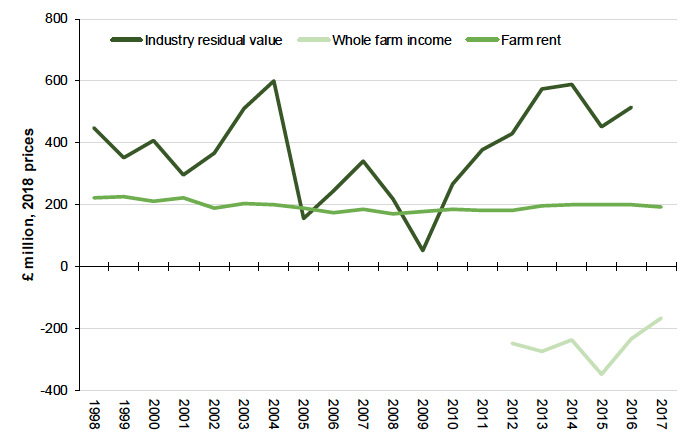
Source: Office for National Statistics and Scottish Government
Using the industry residual value, agricultural biomass provisioning service annual valuations show a high of £597 million in 2004 and a low of £49 million in 2009. In 2016, the agricultural biomass annual valuation was £514 million, making up 12% of the UK value.
Marine fish capture
Rising marine fish capture in Scottish waters has driven UK growth since 2003
We have been working to improve our fisheries statistics and more work is needed. We rely on a range of external sources, which all involve known uncertainties.
For instance, Norway and Faroese landings are excluded from this analysis. The economic data are based on UK fleet data, which we also apply to foreign vessels that may face different costs and prices. In addition, UK boundaries do not perfectly align with the geographical areas of fish capture statistics. For more detail on how fish capture in UK waters is estimated, see the Marine Management Organisation Exclusive Economic Zone Analysis and associated publications.
Aquaculture or farmed fish, like farmed livestock, have been removed from estimates as farmed fish are viewed as a produced asset and not a natural asset. For more information on the method please see the methodology section.
Fish capture in Scottish waters has risen from 628 thousand tonnes in 2003 to 1,065 thousand tonnes in 2016, an increase of 72% over the period (see Figure 7). We can also see that Scotland has always made up a large proportion of the overall UK fish capture, gradually increasing over time; in 2003, Scotland made up 61% of the UK total. This increased by 18 percentage points by 2016, meaning Scotland made up nearly four-fifths of total UK fish capture.
Marine fish capture in UK waters by country, 2003 to 2016
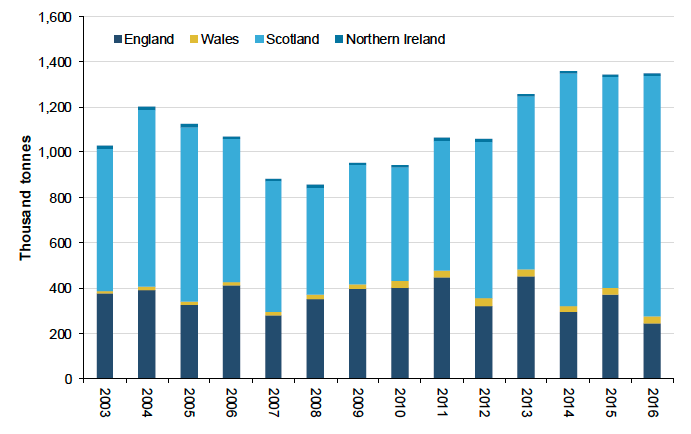
Source: Scientific, Technical and Economic Committee for Fisheries
There were 266 unique fish species caught in UK waters in 2016, 150 of which were found in Scottish waters. Some fish species were only caught in Scottish waters within the UK, such as Norway Pout and Black Scabbardfish to name a couple. However, the 10 fish species with the greatest tonnage captured represent 79% of total UK waters' fish capture, with 90% of these species caught in Scottish waters. Also, landings of Scottish vessels have grown dramatically since 2014 because of an increase in mackerel landings according to the UK Seas Fisheries 2016 Report.
Top 10 fish species by tonnage in the UK and Scotland, 2016
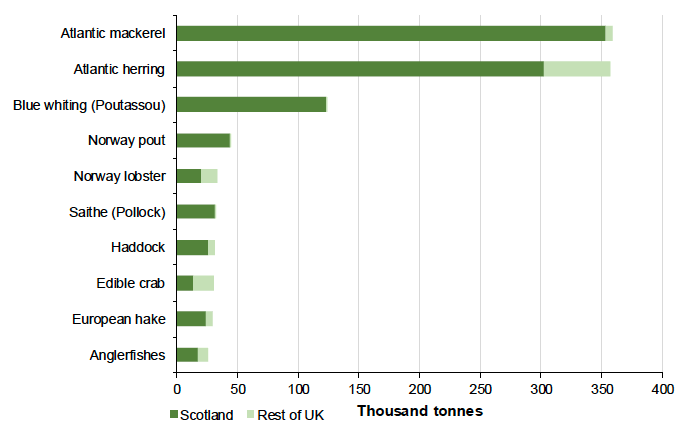
Source: Scientific, Technical and Economic Committee for Fisheries
Out of the 266 unique fish species caught in UK waters in 2016, the top 10 species by gross annual value made up 72% of the overall UK annual value. Whilst some of these species overlap with the highest tonnage species, such as Atlantic mackerel and herring, other species such as common sole are amongst the most valuable. Common sole was the most valuable species not caught in Scottish waters. The most valuable species caught almost entirely in Scottish waters was blue whiting (Poutassou), with a gross annual value of £2.8 million in 2016.
Top 10 fish species by annual value in the UK and Scotland (gross profit), 2016
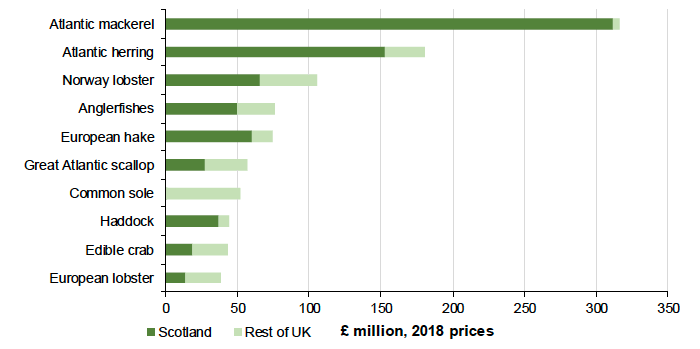
Source: Scientific, Technical and Economic Committee for Fisheries and Seafish
The value of fish capture is calculated using net profit per tonne (landed) estimates, provided by Seafish, for different marine species. Figure 10 shows the annual value of fish provisioning in the UK in 2015 and 2016.
We can see that Scotland's net profit is greater than the rest of the UK, having increased by 125% between 2015 and 2016, from £108.3 million to £243.4 million. The other UK countries remained relatively stable between the same periods, contributing less to the UK net profit total.
Annual value of fish provisioning (net profit), UK, 2015 to 2016
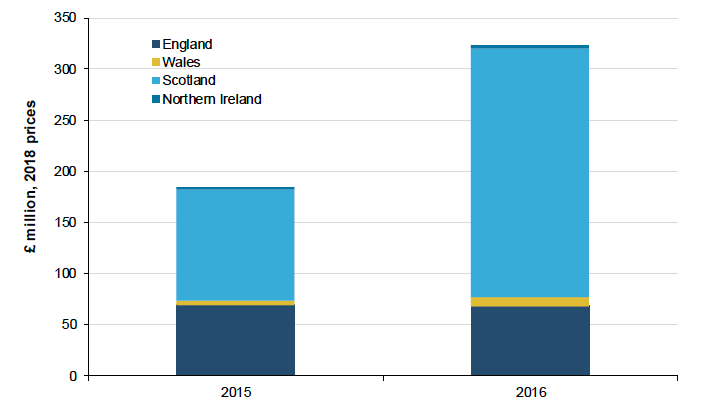
Source: Scientific, Technical and Economic Committee for Fisheries and Seafish
Mackerel makes up around one-third of all species fished in Scottish waters and the net profit for mackerel more than doubled between 2015 and 2016. According to the 2016 Scottish Sea Fisheries Statistic Report, mackerel was Scotland's most valuable stock for that year, with the average price increasing by around 35%, from £664 per tonne in 2015 to £895 per tonne in 2016.
Timber
Timber production in Scotland has doubled between 1997 and 2018
Timber production in Scotland increased by 106% between 1997 and 2018. In 2018, 9,188 thousand cubic metres overbark (m3) was removed. Between 2017 and 2018, there has been a 7.5% increase in timber removals compared with 2.4% between 2016 and 2017.
In 1997, the Forestry Commission produced 51% of the Scottish softwood production. This peaked in 2000, with 60% being produced, but has declined to 33% in 2018.
In the last 10 years, timber production has mainly come from the private sector, which has increased by 77.7% since 2008. Private sector timber production in 2018 was at its highest level of 6,203 thousand cubic metres overbark. In 2018, timber production from Forestry and Land Scotland (public sector) had risen by 34.2% since 1997. In comparison, the private sector had shown an increase of 176.8% for the same period.
The change is primarily the result of differences in the age structure and timing of timber production between woodlands on the public and private forest estates following a period of high levels of planting by the private sector in Scotland between 1970 and the late 1980s.
Timber production in Scotland, 1997 to 2018
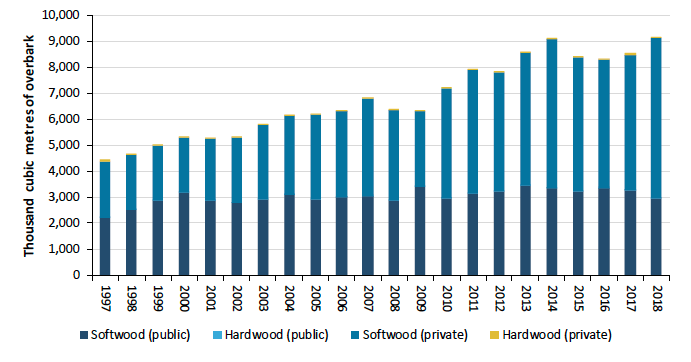
Source: Forest Research
Notes:
1. Public refers to Forestry and Land Scotland.
As can be seen from Figure 12, Scottish production has driven the UK trend. In 1997, Scotland produced 48.5% of the UK's total timber production but this has risen to 62.5% in 2018.
Looking at woodland area and planting data published by Forest Research this is not surprising as Scotland represents 66% of UK conifer (softwood) woodland area and the extent of Scottish woodland has been increasing at a faster rate than that of both England and Wales since 1998. Data published in the Forest Research Forestry Statistics 2019 show woodland area in Scotland has increased 12% between 1998 and 2019 while woodland areas in both England and Wales have expanded by only 6% and 3% respectively. Scotland represented 84% of new planting in 2019.
Timber production, UK, 1976 to 2018
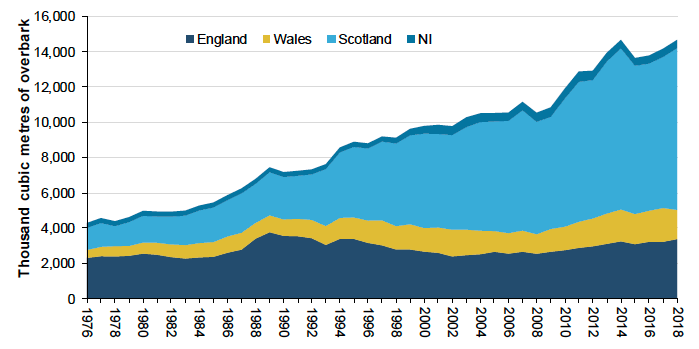
Source: Forestry Research
Timber valuation for Scotland has steadily increased from £67.77 million in 2009 to its highest level of £226.40 million in 2018. This increase in the annual value was caused by trends in stumpage prices, which have increased from £10.67 in 2009 to £24.64 in 2018. The stumpage price is the price paid per standing tree for the right to harvest timber from a given area.
Timber provisioning annual value, Scotland, 1985 to 2018
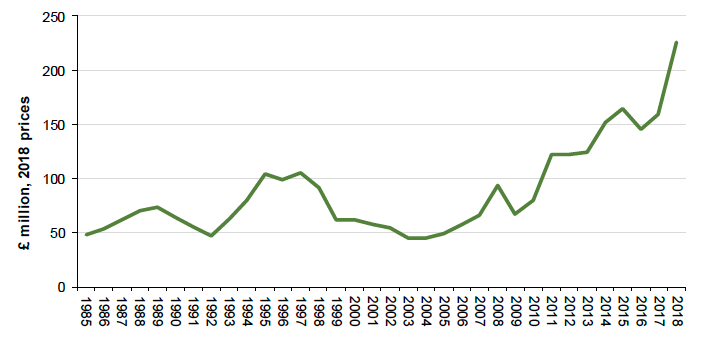
Source: Office for National Statistics and Forest Research
Water abstraction
From 2002 to 2018, the amount of water abstracted for public water supply in Scotland decreased by 24%, from 912 million to 690 million cubic metres. However, the recent trend has shown a rise in water abstraction, which increased by 4%, from 662 million to 690 million cubic metres in 2018.
Despite reduced leakages between 2017 and 2018, water abstraction increased with greater demand. Scottish water abstraction for public water supply made up between 10% and 13% of UK water abstraction levels, across 2002 to 2018.
Water abstraction for public water supply, Scotland, 2002 to 2018
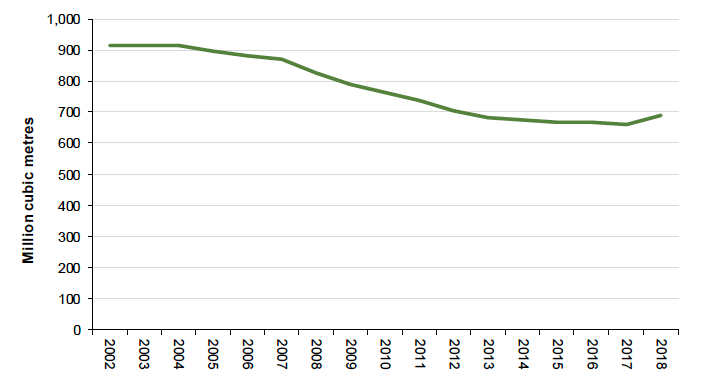
Source: Scottish Water
The value of water abstraction continued to fluctuate between 2002 and 2016, with a peak of £153.84 million in 2003 and a low of £50.42 million in 2009. We derive the monetary estimates from information about economic activity, which relates to the collection, treatment and supply of water.
Although Scotland does not regularly suffer from long-term dry spells, localised areas can experience short-term dry periods, which can cause environmental problems. Climate change predictions from the Scottish Environment Protection Agency suggest that summers in Scotland are likely to get drier (PDF, 898KB). This may place pressure on areas not previously affected by water scarcity in Scotland.
Minerals
The total mineral production in Scotland has decreased by 4% between 2016 and 2017. Mineral production peaked in 2007 with 39.4 million tonnes extracted but by 2017, this had declined by 9.9 million tonnes.
In the 10 years between 2007 and 2017, mineral production in Scotland decreased by 26%. Igneous rock fell by 29% and sand and gravel by 35.1% over the 10-year period.
Scottish mineral production, 1996 to 2017
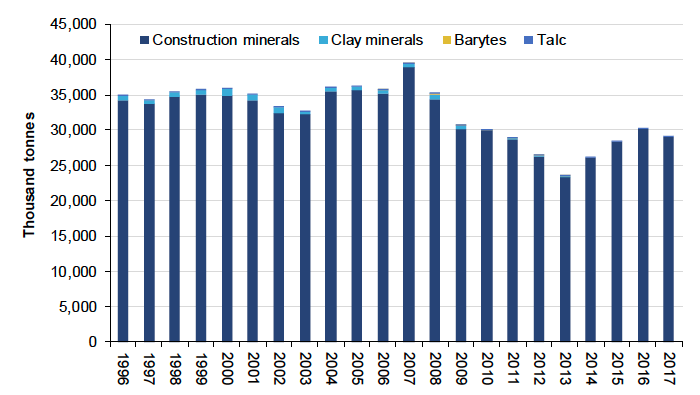
Source: British Geological Survey
Notes:
1. Construction minerals include sand and gravel, slate, igneous rock, limestone and dolomite, and sandstone.
2. Clay minerals includes fireclay, and clay and shale.
3. Mineral extraction after 2014 is estimated based on sales data.
The major source of barytes in the UK is from the Foss mine in Scotland. Barytes is used as a weighting agent for drilling fluids in oil and gas exploration (British Geological Survey). New production will start in the Duntanlich mine in Perthshire from December 2020.
Construction minerals are used for housing and infrastructure. The largest extraction declines were seen in 2008 and 2009, dropping 11.7% and 12.5% respectively. New house building in Scotland declined by 18.9% and 24.7% across the same periods. Since 2013, construction mineral production and new house builds have generally increased each year. This analysis excludes imports, exports, and movement of materials from within the UK.
Scottish construction mineral production, 1997 to 2017
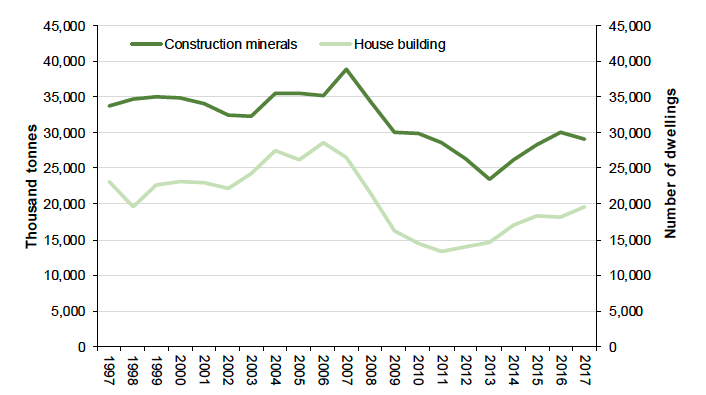
Sources: British Geological Survey and Scottish Government
Notes:
1. Construction minerals include sand and gravel, slate, igneous rock, limestone and dolomite, and sandstone.
2. All sector new builds. A dwelling is regarded as started on the date that work begins on the foundations of the block of which the dwelling will form a part, and not on the date when site preparations begin.
In 2017, igneous rock accounted for 64.4% of the total construction minerals in Scotland. Igneous rock is formed through the cooling and solidification of magma. It is used for the construction of monuments, buildings and interior decoration, for example, kitchen worktops.
Sandstone production has increased by over 103% between 2007 and 2017. It accounted for 20.2% of the total construction minerals in Scotland in 2017. Sandstone is used for new buildings and the repair and maintenance of historic monuments.
Breakdown of Scottish construction minerals, 1997 to 2017
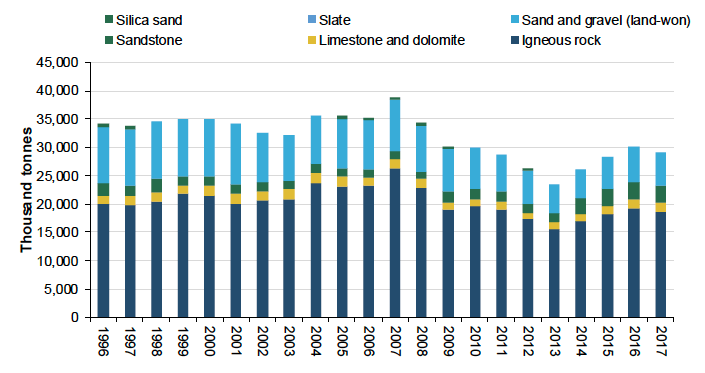
Source: British Geological Survey
Notes:
1. Data for slate, gypsum and chalk not available.
2. Construction minerals include sand and gravel, gypsum, chalk, slate, silica sand, igneous rock, limestone and dolomite, and sandstone.
Scotland's construction mineral comparison with UK
In the 10 years since 2007, UK construction minerals extraction has seen a 18.3% reduction compared with Scotland's 25.4%. In 1997, Scotland produced 11.7% of the UK's construction minerals, growing to a peak of 17.5% in 2008. In 2017, Scotland's share of UK mineral production was 14.6%.
Using the resource rent approach (see Methodology guide), the annual value of mineral provisioning fluctuated between 1998 and 2016. There are costs incurred for making use of natural resources, and in 1999 and 2010 these estimated costs outweighed income from the extraction of minerals. In 2016, the annual value increased to £133 million.
Annual value of mineral extraction, Scotland, 1998 to 2016
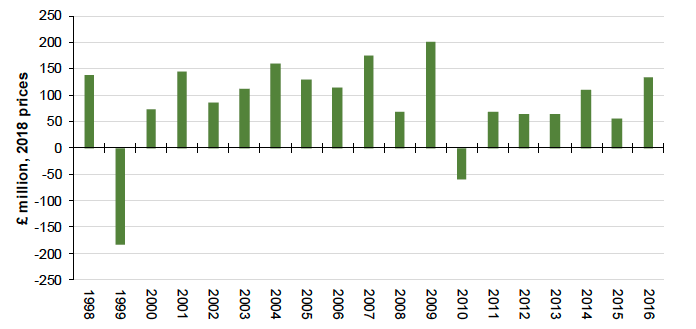
Source: Office for National Statistics
Unstable valuations of the mineral production abiotic provisioning service and years of negative gross operating surplus for the minerals industry in the UK National Accounts do not lend well to valuation comparisons between the UK and Scotland. Data inputs and methods will be reviewed in future accounts.
Fossil fuels
Section 9 provides details on the methodology used to estimate the value of oil and gas production. This is a "resource rent" approach, which estimates the surplus remaining to the extractor after all costs and normal returns are considered. This is closely related to profitability.
Resource rent is different from an intrinsic measure of value such as the wholesale price determined by the market or the value it provides to the economy in terms of economic output (that is, gross value added). Resource rent does not value, as benefits, government receipts, employment, supply chain activity or energy security.
Fossil fuel production, UK, 1998 to 2018
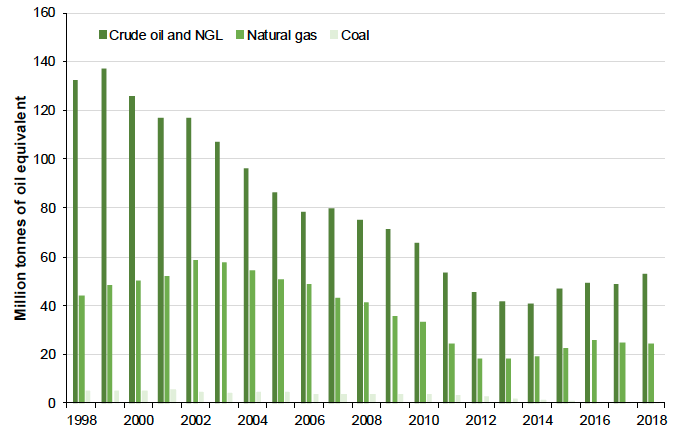
Source: Scottish Government and Department for Business, Energy and Industrial Strategy
Oil and gas production peaked around the start of the century and has gradually declined since. In recent years Scotland has made up 95% of UK oil production and 68% of gas.
With government policy to end coal-fired energy generation by 2025, coal extraction is generally being phased out across Great Britain. As of 2016, there are no coal power stations in Scotland. In 2018, Scottish coal production fell to an all-time low of 0.4 million tonnes of oil equivalent – about 8% of the quantity extracted 20 years earlier.
Fossil fuels' annual value, Scotland, 1998 to 2018
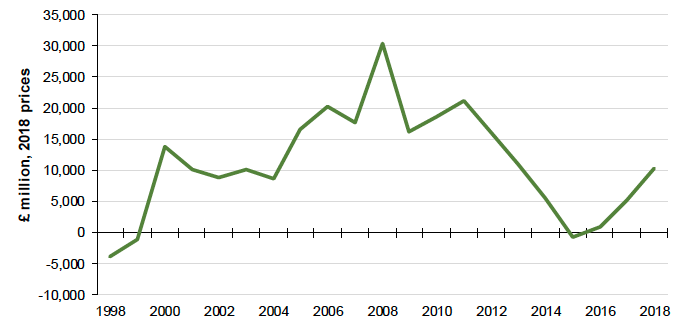
Source: Office for National Statistics
Notes:
1. Because of data limitations, 2017 and 2018 values exclude valuation of coal provisioning but in recent years, coal has had little influence on overall trends.
The annual valuation of fossil fuels abiotic provisioning has varied, driven largely by oil and gas price changes and production trends.
The largest year-on-year real price increases were seen from 1999 to 2000 (67% for oil and 100% for gas), which saw gas prices double, and 2007 to 2008 (41% for oil and 69% for gas). These spikes are reflected in the annual valuation. In 2018, the annual value increased to £10.28 billion, 89% of the UK value, because of oil and gas price increases of 24% and 31% respectively.
Renewable energy
Scotland's renewable electricity generation has increased by 7% between 2017 and 2018. National and international incentives, including the EU Renewable Energy Directive and Renewable Obligation (RO) target, have helped contribute towards the increase.
Hydro power declined 5.4% between 2017 and 2018. The annual rainfall in Scotland has decreased by 8.3% for the same period. The hydro generation load factor has also shown a decrease of 4.1% for small-scale and 8.2% large-scale production. A load factor is a measure of generation efficiency being the utilisation of total generation capacity.
According to the Met Office climate projections Scotland is likely to experience generally wetter winters and drier summers, alongside general warming, which will impact the electricity from weather-dependent renewables.
Figure 21: With drier weather, hydroelectricity generation dropped 32.9% in 2010
Average rainfall and hydroelectricity generation, Scotland, 2000 to 2018
Source: Scottish Government and Met Office
Since 2010, wind power has become the largest source of renewable generation in Scotland. Wind power in 2018 was nearly six times larger than it was in 2008. In 2018, wind power produced almost 72% of the Scottish renewable electricity generation.
Electricity generated from renewable sources, Scotland, 2000 to 2018
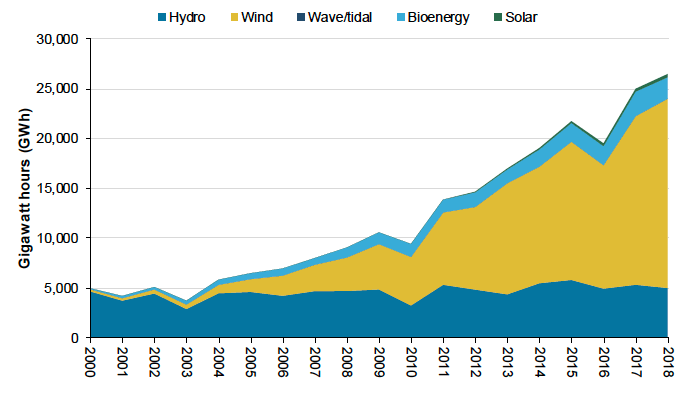
Source: Scottish Government and Department for Business, Energy and Industrial Strategy (Dukes)
Notes:
1. Bioenergy includes landfill gas, sewage gas, and other bioenergy.
In 2000, Scotland produced 50.1% of the UK's renewable electricity generation. This has since declined to 24.1% in 2018. This is because hydropower, which is largely in Scotland, was historically the largest renewable electricity generation source in the UK. Although its generation has remained stable, with other renewables growth across the UK, Scottish hydropower now only accounts for less than 5% of UK renewable generation, down from around 22% in 2008.
Percentage of UK renewable generation from Scottish sources, 2000 to 2018
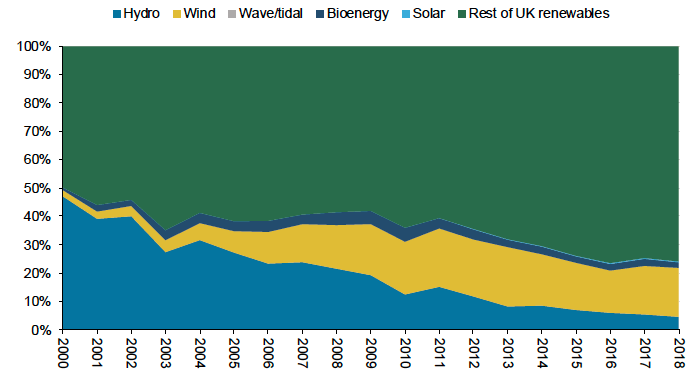
Source: Department for Business, Energy and Industrial Strategy
Notes:
1. Bioenergy includes landfill gas, sewage gas, and other bioenergy.
In 2008, Scottish renewables produced 18.1% or 9,058.5 gigawatt hours (GWh) of electricity generated from all sources (50,038.4 GWh). This has increased every year to a high of 54.9% or 26,472.5 GWh in 2018. Between 2017 and 2018, electricity production increased by 6% and electricity production from non-renewables decreased by 7%.
Electricity production generation from renewable and non-renewable sources, Scotland, 2004 to 2018
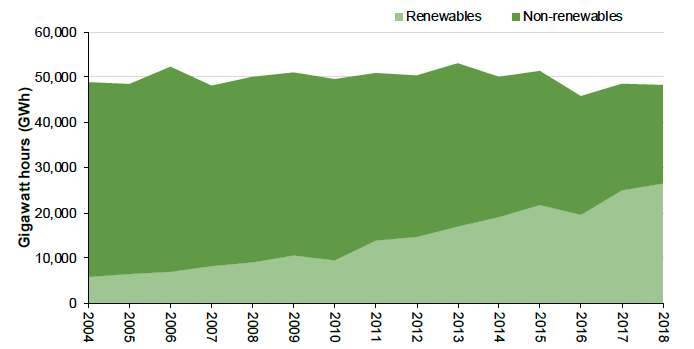
Source: Department for Business, Energy and Industrial Strategy
Notes:
1. Renewables includes wind, hydro, solar, wave and tidal, and bioenergy.
2. Non-renewable includes coal, oil, gas, nuclear, other thermal, hydro pumped storage, and non-biodegradable waste combustion.
The annual value of renewable energy provisioning, being the additional service humans capture from wind, sun, and rain, increased eight-fold between 2008 and 2016, with the growth of the renewables sector. In 2016, the service was worth £199 million, 29% of the UK value.
Contact
There is a problem
Thanks for your feedback